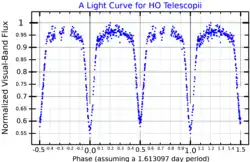| Observation data Epoch J2000.0 Equinox J2000.0 | |
|---|---|
| Constellation | Telescopium |
| Right ascension | 19h 51m 58.93159s[2] |
| Declination | −46° 51′ 42.4354″[2] |
| Apparent magnitude (V) | 8.22[3] (Max) |
| Characteristics | |
| Spectral type | A7III(m)[4] |
| Variable type | Algol[5] |
| Astrometry | |
| Radial velocity (Rv) | −5.91±0.09[6] km/s |
| Proper motion (μ) | RA: +1.814[2] mas/yr Dec.: −33.369[2] mas/yr |
| Parallax (π) | 3.5831 ± 0.0796 mas[2] |
| Distance | 910 ± 20 ly (279 ± 6 pc) |
| Orbit[6] | |
| Period (P) | 1.613097 d |
| Semi-major axis (a) | ≥0.019±0.0001 AU |
| Eccentricity (e) | 0.00[7] |
| Inclination (i) | 82.7±0.5[8]° |
| Periastron epoch (T) | 2,451,875.06581±0.00027 HJD |
| Semi-amplitude (K1) (primary) | 131.11±0.18 km/s |
| Semi-amplitude (K2) (secondary) | 142.35±0.18 km/s |
| Details | |
| A | |
| Mass | 1.88±0.04[1] M☉ |
| Radius | 2.28±0.15[1] R☉ |
| Age | 1.1[1] Gyr |
| B | |
| Mass | 1.73±0.04[1] M☉ |
| Radius | 2.08±0.16[1] R☉ |
| Other designations | |
| Database references | |
| SIMBAD | data |
HO Telescopii is an eclipsing binary star system located in the southern constellation of Telescopium. The maximum apparent visual magnitude of 8.22[3] is too faint to be visible to the naked eye. The system is located at a distance of approximately 910 light years based on parallax.[2] The combined stellar classification of the system is A7III(m),[4] matching an evolved A-type star[10] that is possibly metallic-lined. The system is around 1.1[1] billion years old and consists of two stars of similar mass and size.[1]
The variability of this system was discovered by W. Strohmeier, R. Knigge, and H. Ott in 1965.[11][12] It is a detached binary system with both components filling three-fourths of their respective Roche lobes.[1] Their orbital period is 1.613097[6] days with a circularized orbit,[7] and the orbital plane is inclined by 83° to the line of sight from the Earth; close to edge-on.[8] As a consequence, they form an Algol-like eclipsing binary with a magnitude decrease of 0.51 during the primary eclipse and 0.45 during the secondary eclipse.[3]
References
- 1 2 3 4 5 6 7 8 9 Sürgit, D.; et al. (July 2017). "Absolute parameters of detached binaries in the southern sky - III: HO Tel". New Astronomy. 54: 109–114. Bibcode:2017NewA...54..109S. doi:10.1016/j.newast.2017.01.013.
- 1 2 3 4 5 6 Brown, A. G. A.; et al. (Gaia collaboration) (August 2018). "Gaia Data Release 2: Summary of the contents and survey properties". Astronomy & Astrophysics. 616. A1. arXiv:1804.09365. Bibcode:2018A&A...616A...1G. doi:10.1051/0004-6361/201833051. Gaia DR2 record for this source at VizieR.
- 1 2 3 Avvakumova, E. A.; et al. (October 2013). "Eclipsing variables: Catalogue and classification". Astronomische Nachrichten. 334 (8): 860. Bibcode:2013AN....334..860A. doi:10.1002/asna.201311942. hdl:10995/27061.
- 1 2 Houk, Nancy (1978). Michigan catalogue of two-dimensional spectral types for the HD stars. Vol. 2. Ann Arbor: Dept. of Astronomy, University of Michigan. Bibcode:1978mcts.book.....H.
- ↑ Samus, N. N.; Durlevich, O. V.; et al. (2009). "VizieR Online Data Catalog: General Catalogue of Variable Stars (Samus+ 2007-2013)". VizieR On-line Data Catalog: B/GCVS. Originally Published in: 2009yCat....102025S. 1: B/gcvs. Bibcode:2009yCat....102025S.
- 1 2 3 Sürgit, D.; et al. (July 2015). Rucinski, Slavek M.; Torres, Guillermo; Zejda, Miloslav (eds.). "First Spectroscopic Solutions of Two Southern Eclipsing Binaries: HO Tel and QY Tel". Living Together: Planets, Host Stars and Binaries, Proceedings of a conference held 8-12 September 2014 in Litomyšl, Czech Republic. ASP Conference Series. San Francisco: Astronomical Society of the Pacific. 496: 258. Bibcode:2015ASPC..496..258S.
- 1 2 Khaliullin, Kh. F.; Khaliullina, A. I. (January 2010). "Synchronization and circularization in early-type binaries on main sequence". Monthly Notices of the Royal Astronomical Society. 401 (1): 257–274. Bibcode:2010MNRAS.401..257K. doi:10.1111/j.1365-2966.2009.15630.x.
- 1 2 Grygar, J.; Horak, T. B. (1980). "Orbital Elements of the Eclipsing Binaries RW CrA and HO Tel from Multicolour Light Curves". Bulletin of the Astronomical Institute of Czechoslovakia. 31: 297. Bibcode:1980BAICz..31..297G.
- ↑ "HO Tel". SIMBAD. Centre de données astronomiques de Strasbourg. Retrieved 2020-12-12.
- ↑ Spoelstra, T. A. Th.; Van Houten, C. J. (1972). "Five-colour photometry of the eclipsing binary HO Telescopii". Astronomy and Astrophysics Supplement. 7: 83. Bibcode:1972A&AS....7...83S.
- ↑ Sistero, R. F.; Candellero, B. A. (August 1979). "HO Telescopii: Light Elements". Information Bulletin on Variable Stars. 1666: 1. Bibcode:1979IBVS.1666....1S.
- ↑ Strohmeier, W.; et al. (February 1965). "Bright Southern BV-Stars". Information Bulletin on Variable Stars. 81: 1. Bibcode:1965IBVS...81....1S.
